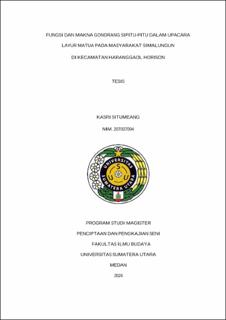Fungsi dan Makna Gondrang Sipitu-Pitu dalam Upacara Layur Matua pada Masyarakat Simalungun di Kecamatan Haranggaol Horison
The Function and Meaning of Gondrang Sipitu-Pitu in the Layur Matua Ceremony in the Simaungun Community in the Haranggaol Horison Sub-District

Date
2024Author
Situmeang, Kasri
Advisor(s)
Sebayang, Vanesia Amelia
Ginting, Pulumun P
Metadata
Show full item recordAbstract
This thesis is entitled "The function and meaning of Gondrang sipitu-pitu in the layur matua ceremony in the Simaungun community in the Haranggaol Horison sub-district". The analysis is focused on (1) the function of Gondrang sipitu-pitu, (2) the meaning of Gondrang sipitu-pitu. The method used is qualitative method with data collection data through field research, interviews, audiovisual data recording. In this case, to describe the meaning of Gondrang sipitu-pitu, the author uses the theory Ferdinand De Saussure. to describe the function of Gondrang sipitu-pitu. Gondrang sipitu pitu used the theory of use and function of Alan P Merriam (1964: 223-226). Research results The research results obtained show that conceptually for the Simalungun community if someone is in Simalungun society if someone is in the status of death layur matua where all his children, grandchildren and great-grandchildren are married, then the person who died is perceived as having succeeded in the person is perceived to have succeeded in the life they left behind. left behind. At the layur matua traditional ceremony there are four types of Gondrang that are used in the ceremony. used in the layur matua ceremony, namely: (1) the first is rambung ramos which means having children and grandchildren, (2) Second, olop-olop which means saying yes, grateful to God, (3) third, panrahut which means to assent, (4) huda-huda which is intended to welcome the tondong to come to accompany dances by wearing topings and hornbill beaks.
